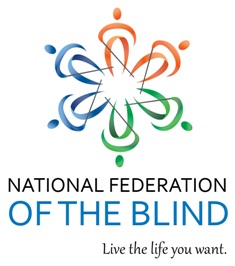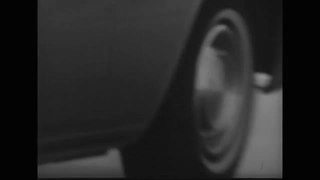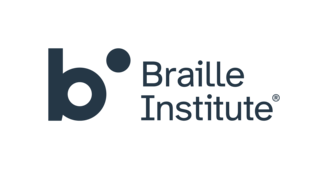A white cane is a device used by many people who are blind or visually impaired. A white cane primarily allows its user to scan their surroundings for obstacles or orientation marks, but is also helpful for onlookers in identifying the user as blind or visually impaired and taking appropriate care. The latter is the reason for the cane's white colour, which in many jurisdictions is mandatory.
Perkins School for the Blind, in Watertown, Massachusetts, was founded in 1829 and is the oldest school for the blind in the United States. It has also been known as the Perkins Institution for the Blind.
The Royal National Institute of Blind People (RNIB) is a UK charity offering information, support and advice to almost two million people in the UK with sight loss.
The American Foundation for the Blind (AFB) is an American non-profit organization for people with vision loss. AFB's objectives include conducting research to advance change, promoting knowledge and understanding, and shaping policies and practices.
Visual impairment, also known as vision impairment, is a medical definition primarily measured based on an individual's better eye visual acuity; in the absence of treatment such as corrective eyewear, assistive devices, and medical treatment– visual impairment may cause the individual difficulties with normal daily tasks including reading and walking. Low vision is a functional definition of visual impairment that is chronic, uncorrectable with treatment or conventional corrective lenses, and impacts daily living. As such low vision can be used as a disability metric and varies based on an individual's experience, environmental demands, accommodations, and access to services. The American Academy of Ophthalmology defines visual impairment as the best-corrected visual acuity of less than 20/40 in the better eye, and the World Health Organization defines it as a presenting acuity of less than 6/12 in the better eye. The term blindness is used for complete or nearly complete vision loss. In addition to the various permanent conditions, fleeting temporary vision impairment, amaurosis fugax, may occur, and may indicate serious medical problems. The abbreviation VIP is sometimes used for Visually Impaired Person, Persons or People.

The CNIB Foundation is a Canadian charitable organization and volunteer agency dedicated to assisting Canadians who are blind or living with vision loss, and to provide information about vision health for all Canadians. Founded in 1918 as the Canadian National Institute for the Blind to assist soldiers who had been blinded in the First World War, CNIB originally offered sheltered care and specialized employment to people with vision loss. It has since expanded to include other programs and services, including research, public education, rehabilitation counselling and training, advocacy and an alternative-format library for people living with a print disability. It is a member of the Braille Authority of North America.

The National Federation of the Blind (NFB) is an organization of blind people in the United States. It is the oldest and largest organization led by blind people in the United States. Its national headquarters are in Baltimore, Maryland.

Orientation and Mobility, or O&M, is a profession which focuses on instructing individuals who are blind or visually impaired with safe and effective travel through their environment. Individual O&M specialists can work for schools, government agencies or work as private contractors. The Academy for Certification of Vision Rehabilitation and Education Professionals (ACVREP) offers certification for vision rehabilitation professionals in the United States.

The Associated Services for the Blind & Visually Impaired (ASB) is a private non-profit organization in Philadelphia, Pennsylvania. It assists those living with vision loss to achieve independence through education, support services to advance necessary skills, and community connections. ASB collaborates with local, regional and national partners to provide additional resources and opportunities to clients.
A sighted child who is reading at a basic level should be able to understand common words and answer simple questions about the information presented. They should also have enough fluency to get through the material in a timely manner. Over the course of a child's education, these foundations are built on to teach higher levels of math, science, and comprehension skills. Children who are blind not only have the education disadvantage of not being able to see: they also miss out on the very fundamental parts of early and advanced education if not provided with the necessary tools.
Christian Record Services for the Blind is a non-profit organization that serves people who are legally blind and visually impaired. "Christian Record Services for the Blind is an international organization serving blind and visually impaired individuals in approximately 70 countries worldwide and employs about 15 people." It is a ministry of the Seventh-day Adventist Church but services blind people regardless of beliefs.

The Braille Institute of America (BIA) is a nonprofit organization with headquarters in Los Angeles providing programs, seminars and one-on-one instruction for the visually impaired community in Southern California. Funded almost entirely by private donations, all of the institute's services are provided completely free of charge. The organization has seven regional centers: Anaheim, Coachella Valley, Laguna Hills, Los Angeles, Riverside, San Diego and Santa Barbara, as well as outreach programs at more than 200 locations throughout Southern California. It is a member of the Braille Authority of North America.

The Lighthouse of Houston is a private, non-profit education and service center dedicated to assisting blind and visually impaired people in the Houston, Texas metropolitan area to live independently. The Lighthouse serves approximately 9,000 people each year and is a member agency of the United Way of Greater Houston.

Linden Lodge School for the Blind is a specialist sensory and physical college located in Wimbledon, South London, England. It educates visually impaired children aged between two and nineteen, including those who are multi-disabled visually impaired.
Warwickshire Vision Support is a registered charity in England providing rehabilitation services for adults with visual impairments to enable them to live independently.
Columbia Lighthouse for the Blind (CLB) is an organization founded to help the blind or visually impaired population of the greater Washington, D.C., region, including the deafblind community, deal with the challenges of vision loss. The goal of CLB is to try to help people who are blind or visually impaired to remain independent, active and productive in society.
The Council of Schools and Services for the Blind (COSB) is a consortium of specialized schools in Canada and the United States whose major goal is improving the quality of services to children who are blind and visually impaired.

Sight Scotland is a Scottish Charity based in Edinburgh, Scotland. The charity provides care, education and employment for people of all ages who are blind or partially sighted. Sight Scotland provides the following services: Royal Blind School, Forward Vision, Braeside House, Jenny's Well, Scottish Braille Press and Kidscene. Sight Scotland’s sister charity is Sight Scotland Veterans.
The LightHouse for the Blind and Visually Impaired is a San Francisco-based nonprofit organization, and is the oldest and largest of its kind in Northern California.








